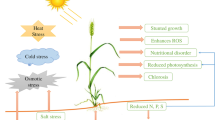Abstract
In contrast with the well document role of proteoid root formation and carboxylate exudation in acclimation to P deficiency in white lupin (Lupinus albus L.), their role under other nutrient deficiencies and their ecological significance are still poorly understood. In the present work, differences in proteoid root formation, exudation of carboxylates by root clusters, non-proteoid and proteoid root tips by using a non-destructive method, and concentrations of organic acids in the tissues of plants grown in the absence of P, Fe or K were studied. Proton release from roots increased soon after withdrawing Fe from the medium; within three days the solution pH decreased from 6 to about 4, and this increased release in protons continued until the end of the experiment. Acidification appeared much later, on the 10th day and the 14th day after withdrawal of P and K, respectively; the extent of the acidification was also weaker than under –Fe (5.2 for –P and 5.7 for control on the 10th day; 6.0 for –K and 6.1 for control on the 14th day). Root clusters formed when plants were grown under –P and –Fe, but not under –K conditions. The root clusters developed sooner under –Fe conditions, but the number of clusters was far less than under –P. Under P deficiency, root clusters released mainly citrate, but also some malate; while the major organic acid released by root tips of both non-proteoid and proteoid roots was malate. However, under Fe deficiency, the majority of the organic acids exuded both by the root clusters and root tips was malate, whereas only a small amount of citrate was detected. The release rate of citrate by – P root clusters was greater than that by – Fe root clusters. Moreover, the release rate of malate was greater in –Fe root clusters than in –P root clusters, but the opposite was found in proteoid root tips, i.e. faster in –P than in –Fe proteoid root tips. The significances of proteoid root formation and release of organic acids in acclimation to different nutrient deficiencies for white lupin plants are discussed.
Similar content being viewed by others
References
Alcantara E, de la Guardia M D and Romer F J 1991 Plasmalemma redox activity and H+ extrusion in roots of Fe-deficient cucumber plants. Plant Physiol. 96, 1034-1037.
Dinkelaker B, Hengeler C and Marschner H 1995 Distribution and function of proteoid roots and other root clusters. Bot. Acta 108, 183-200.
Gardner W K, Parbery D G and Barber D A 1982 The acquisition of phosphorus by Lupinus albus L. I. Some characteristics of the soil /root interface. Plant Soil 68, 19-32.
Gardner W K, Barber D A and Parbery D G 1983 The acquisition of phosphorus by Lupinus albus L. III. The probable mechanism by which phosphorus movement in the soil /root interface is enhanced. Plant Soil 70, 107-124.
Gilbert G A, Knight J D, Vance C P and Allan D L 1999 Acid phosphatase activity in phosphorus-deficient white lupin roots. Plant Cell Environ. 22, 801-811.
Hagström J, James W M and Skene K R 2001 A comparison of structure, development and function in cluster roots of Lupinus albus L. under phosphate and iron stress. Plant Soil 232, 81-90.
Hinsinger P, Barros O N F, Benedetti M F, Noack Y and Callot G 2001 Plant-induced weathering of a basaltic rock: Experimental evidence. Geochim. Cosmochim. Acta 65, 137-152.
Hinsinger P and Jaillard B 1993 Root-induced release of interlayer potassium and vermiculitization of phlogopite as related to potassium depletion in the rhizosphere of ryegrass. J. Soil Sci. 44, 525-534.
Hinsinger P, Elsass F, Jaillard B and Robert M 1993 Root-induced irreversible transformation of a trioctahedral mica in the rhizosphere of rape. J. Soil Sci. 44, 535-545.
Jones D L 1998 Organic acids in the rhizosphere-a critical review. Plant Soil 205, 25-44.
Lindsay W L and Schwab A P 1982 The chemistry of iron in soil and its availability to plants. J. Plant Nutr. 5, 821-840.
Ma J F 2000 Role of organic acids in detoxification of aluminium in higher plants. Plant Cell Physiol. 41, 383-390.
Marschner H 1995 Mineral Nutrition of High Plants. Academic Press, London.
Marschner H, Römheld V and Kissel M 1986 Different strategies in higher plants in mobilization and uptake of iron. J. Plant Nutr. 9, 695.
Marschner H, Römheld V and Cakmak I 1987 Nutrition availability in the rhizosphere. J. Plant Nutr. 10, 1174-1184.
Neumann G and Römheld V 1999 Root excretion of carboxylic acids and protons in phosphorus-deficient plants. Plant Soil 211, 121-130.
Neumann G and Römheld V 2001 The release of root exudates as affected by the plant's physiological status. In The Rhizosphere, Biochemistry and Organic Substances at the Soil-Plant Interface. Eds. R Pinton, Z Varanini and P Nannipieri. pp. 41-93. Marcel Dekker, Inc. New York.
Neumann G, Massonneau A, Martinoia E and Römheld V 1999 Physiological adaptations to phosphorus deficiency during proteoid root development. Planta 208, 373-382.
Rabotti G and Zocchi G 1994 Plasma membrane-bound H+ ATPase and reductase activities in Fe-deficient cucumber roots. Physiol. Plant. 90, 779-785.
SAS Institute Inc. 1987 SAS/STAT guide for personal computers, 6th edn. Cary, NC.
Skene K R 2001 Cluster roots: model experimental tools for key biological problems. J. Exp. Bot. 52, 479-485.
Wang J G, Zhang F S, Zhang X L and Cao Y P 2000 Release of potassium from K-bearing minerals: Effects of plant roots under P deficiency. Nutrient Cycling in Agroecosystems 56, 45-52.
White P F and Robson A D 1989 Effect of soil pH and texture on the growth and nodulation of lupins. Aust. J. Agric. Res. 40, 63-73.
Author information
Authors and Affiliations
Corresponding author
Rights and permissions
About this article
Cite this article
Liang, R., Li, C. Differences in cluster-root formation and carboxylate exudation in Lupinus albusL. under different nutrient deficiencies. Plant and Soil 248, 221–227 (2003). https://doi.org/10.1023/A:1022367513025
Issue Date:
DOI: https://doi.org/10.1023/A:1022367513025




